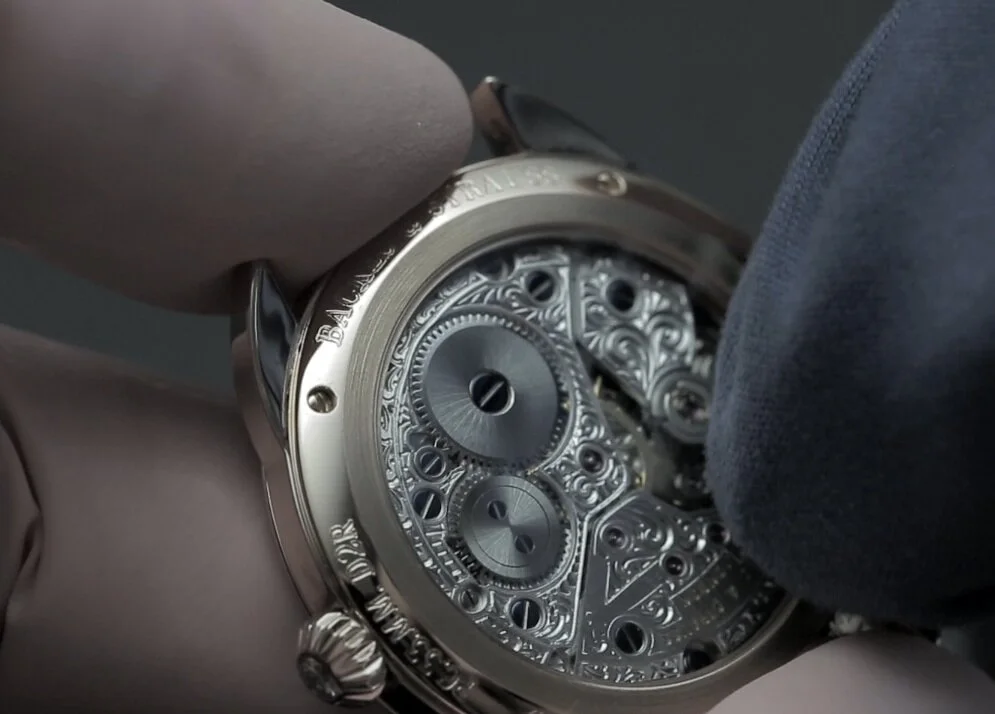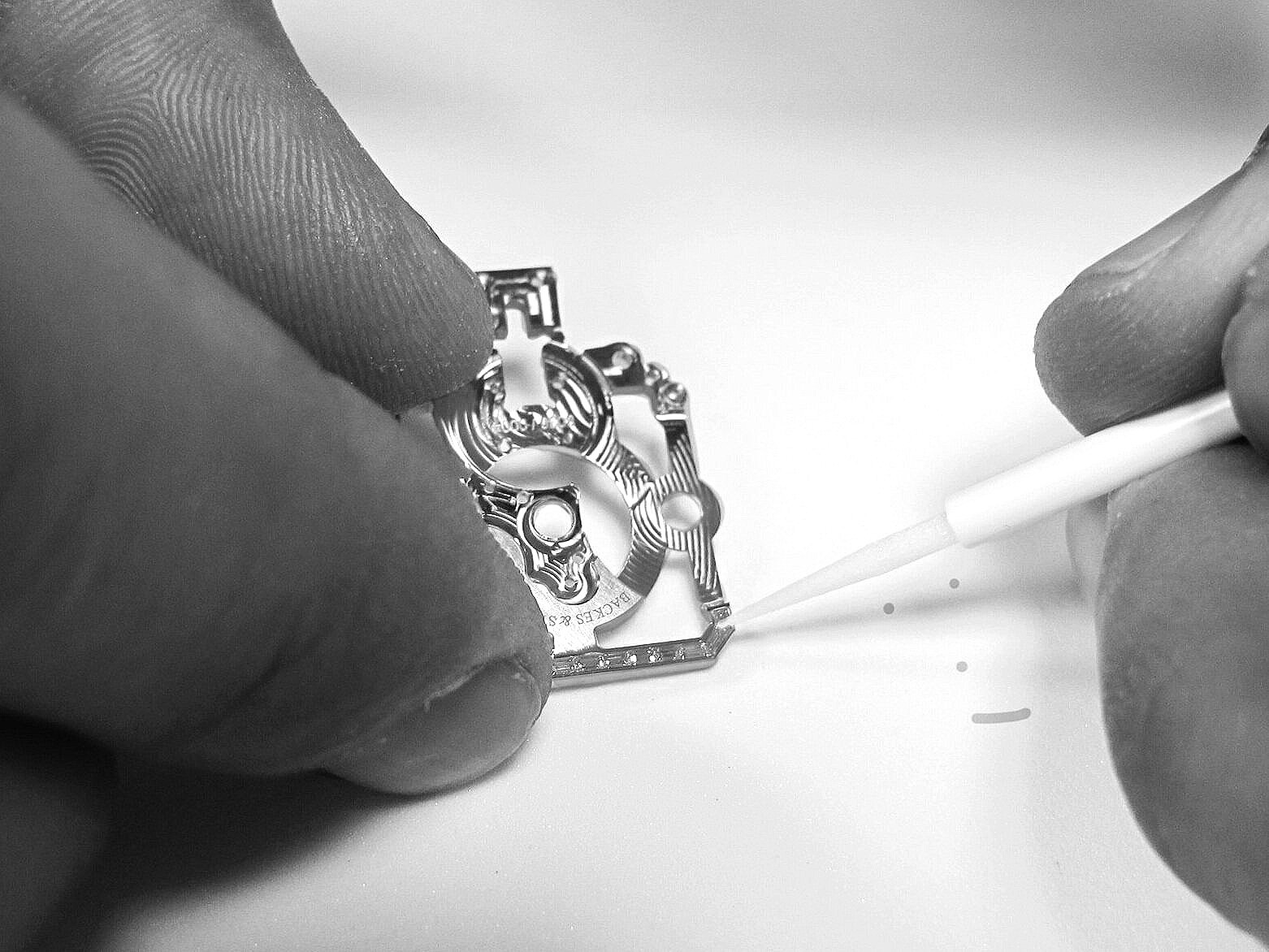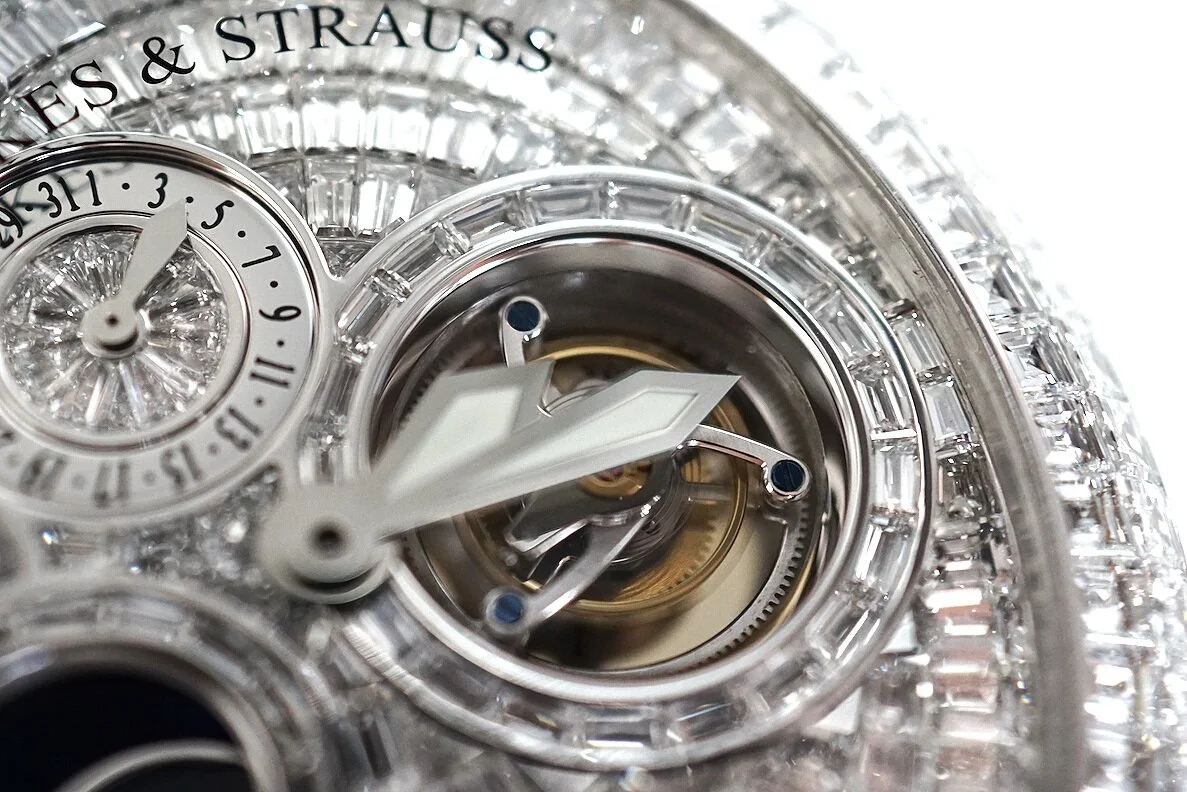The Movement
© Madame Sketch | @madame.sketch for Backes & Strauss
Symbolising the heart of the timepiece, the Watch Movement encompasses an intricate series of mechanisms that function sequentially to deliver the seamless movement of the watch hands. Backes & Strauss classic collection features three types of movements: Mechanical, which is comprised of Manual and Automatic, and Quartz. However, the most exquisite of Backes & Strauss’ diamond watches house the bespoke movements.
Every Backes & Strauss timepiece comes with a two-year free service entitlement as well as a guarantee booklet, where you will find details on how to care for your watch movement.
Backes & Strauss Manual Winding Movement
The Classic Movements
One of the oldest and most popular forms of the watch movement is the manual mechanical movement. Its exceptionally delicate components are all hand-assembled by master Backes & Strauss craftsmen to guarantee a luxurious lifelong timepiece. To power the timepiece, the mainspring is periodically wound by hand to create and store energy. The gear train transfers this energy to the escapement, which maintains the oscillations of the balance wheel and ensures that the energy is released in equal, regular parts. Finally, the dial train transmits the regulated energy to the watch hands, powering their movement and enabling the time to be displayed with an accuracy of one second lost or gained per day. This particular movement is featured in the Renaissance Collection, where the wonderfully slim timepieces expose a magnitude of craftsmanship on the decorated movement through the case’s open back.
Backes & Strauss Bespoke Movement - The Earl of Strauss Brilliant
The Earl of Strauss Brilliant is a bespoke manual-winding mechanical movement of which the bridge in the back has been set with 167 white Ideal Cut diamonds (0.75cts). In homage to the company’s co-founding father, Max Strauss, this exquisite timepiece features an Ostrich trademark on the balance wheel - with ‘Strauss’ being the German word for ostrich.
Automatic movements have a similar internal mechanism to that of a manual, but with the addition of an oscillating weight called a rotor. The rotor, which is usually made of platinum or gold, functions by rotating freely with each movement of the wearer’s wrist and thus transferring energy to the mainspring. As long as the watch is worn regularly, it won’t require winding, but occasional manual winding will be necessary to garner initial power. Those who admire this form of mechanical movement will find framed within Backes & Strauss’ Classic Collection and Exclusive Watches an array of vibrant and unique automatic timepieces.
Backes & Strauss Moon Phase Watch - Regent 1609 AD
The limited edition Regent 1609AD honours old-world timekeeping with a hand-wound tourbillon movement and incorporates modern features such as a date display and moon phase indication. Its dial reveals the different phases of the moon in midnight blue and is set with 17 diamonds, portraying the Great Bear Constellation.
Contrastingly, quartz movements are battery powered and have superior accuracy. The battery sends an electrical current through a tiny quartz crystal. Once electrified, the crystal creates 32,768 vibrations per second which cause the movement to oscillate and drive the motor to move the watch hands. Quartz movements make for low maintenance and durable watch owing to fewer moving parts and the presence of a battery. They are also a favourite for Backes & Strauss’ Victoria Collection, which hosts bejewelled cocktail watches with an interlocking heart motif for ladies.
Tourbillon Movement
Backes & Strauss Bespoke Tourbillon Movement
A true form of mechanical art, tourbillon, whether manual or automatic, is a mechanism that improves the precision and accuracy of the watch movement by counteracting the effects of gravity. As gravity creates a drag on the movement, a rotating cage is placed onto the escapement and balance wheel to keep all the intricate components in place. French for ‘whirlwind’, tourbillon is exactly that. Where a balance wheel oscillates, tourbillon rotates in one direction, completing a full 360 rotation every 60 seconds. It is remarkably mesmerising to look at and therefore placed on the dial to impress onlookers with its complex yet delicate beauty.
At Backes & Strauss, the tourbillon movement symbolises superior craftsmanship and a constant endeavour to achieve new horological heights, both technically and aesthetically. Many of the exquisite tourbillon timepieces form part of the Backes & Strauss Masterpiece collection of exclusive watches, and they are one-of-a-kind, of which you can be the sole owner in the world. The Berkeley Emperor Tourbillon, for instance, marks Backes & Strauss’ first venture into tourbillon wristwatches. The hand-winding skeleton tourbillon movement is set with 60 white baguette-cut diamonds, 0.81 cts at 1, 3, 5, 7, 9 and 11 o’clock.
The Regent Tourbillon Pocket Watch honours old-world timekeeping with a hand-wound tourbillon movement and incorporates modern features such as a date display and moon phase indication. The Berkeley Duke Tourbillon timepieces house the brand’s very first automatic movement with a rotor peripheral, visible via the open back case, turns around the movement. The King Tourbillon has an automatic tourbillon movement. Its open back case showcases the rotor engraved with the London Skyline. The rest of the movement is set with 204 white ideal cut diamonds.
Movement Regulation
Crucial in ensuring a beautiful ticking timepiece, regulation refers to the process of adjusting the tension on the balance spring - a fine helical spring attached to the balance wheel in mechanical watches. It requires immense technical brilliance and patience from Backes & Strauss’ horologists, as even the minutest adjustment to the balance spring can affect the speed of the timepiece. To speed up the movement of the watch hands, the watchmaker must shorten the length of the spring, thus permitting the balance wheel to complete its swing quicker. Lengthening the spring will do the opposite and the watch will consequently lose time.
Aesthetics and Functionality
To amplify the exclusivity of a timepiece, Backes & Strauss watchmakers decorate the movement surfaces with traditional or bespoke motifs. These finishing touches are not exclusively for aesthetic purposes but in fact enhance the timepieces durability, functionality and longevity.
One of the most traditional decoration motifs is the Côte de Genève or Geneva stripes. The visible flat surfaces of the bridge are elegantly hand-adorned with regular parallel wave-like lines, which can be straight or circular. Soleillage, on the other hand, flaunts straight lines originating at the centre and radiating outwards to the periphery of the wheel, mimicking the rays of the sun.
Also known as stippling, Perlage features a pattern of overlapping small circles on the movement plates or bridges. It requires an abundance of artistic talent and a skilled eye to ensure the placement of each swirl harmoniously overlaps the previous one. To create the circular pattern, Backes & Strauss craftsmen must repeatedly press a rotating grinding tip on the movement, with the tightness or looseness of this pattern left entirely to their impulse. Equally functional as it is artistic, perlage helps to prevent any corrosion on the movement.
Alongside the classic movements, Backes & Strauss also offer bespoke movement decorations which are generally realised on the oscillating weight and the movement bridges.









